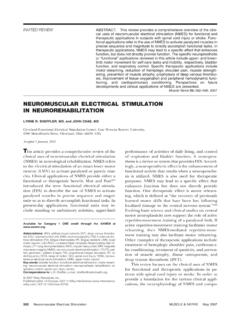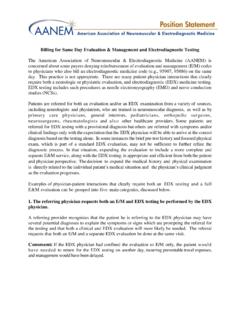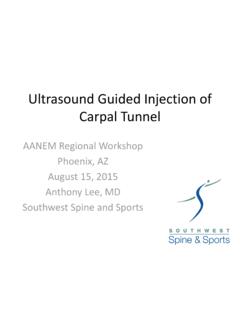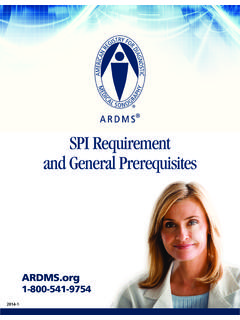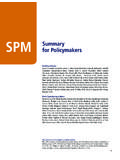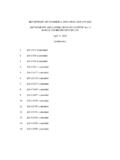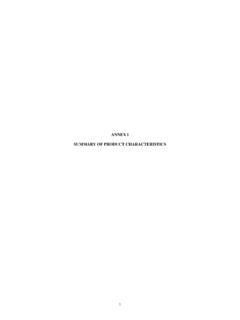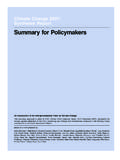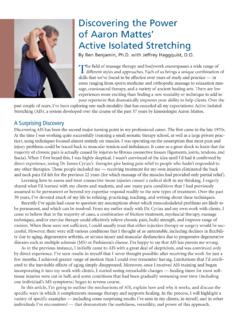Transcription of Basic Nerve Conduction Studies - AANEM
1 Basic Nerve Conduction Studies Holli A. Horak, MD. University of Arizona August 2015. Introduction Review Nerve physiology/ anatomy Purpose of testing Study design Motor NCS. Sensory NCS. Mixed NCS. Interpretation Technical considerations Summary Anatomy Motor Neuron Axon Myelin Neuromuscular Junction Muscle fibers Anatomy Dorsal Root ganglion: Bipolar Nerve cell One projection central Dorsal column Other axon distal Sensory end organ Myelinated: different degrees Anatomy Neurons AHC. DRG. Roots Rami Ventral Rami: Plexus Dorsal Rami: Paraspinals Anatomy Certain nerves are routinely studied Location Size Important pathology Ease of evaluation Some are less often studied Some are rarely studied Study Design Answer the clinical question Not just routine Specifically choose Nerve evaluation needed Motor NCS.
2 Sensory NCS. Repetitive stimulation Other (mixed study). Least number of NCS needed to answer the clinical question CTS. Purpose of testing Neuropathy Other conditions Focal . Carpal Tunnel Syndrome (CTS). Radiculopathy Peroneal neuropathy Ulnar neuropathy Neuromuscular junction defects Generalized Diabetic Neuropathy Myasthenia Gravis Guillain Barre syndrome (GBS). LEMS. Axonal Motor Neuron Disease Diabetic Neuropathy Nerve transection ALS. Demyelinating Sensory Neuronopathy GBS. CTS. Sjogren's disease Motor Nerve Conduction Studies Larger More reproducible Troubleshooting is easier Why? Compound Muscle Action Potential Muscle amplifies the response Stimulate Nerve axons Causes muscle to contract Recording the muscle contraction Response is in millivolts (1000X larger than SNAP). Few anatomic variations Large motor axons tend to be affected late in disease states Motor NCS.
3 Belly-Tendon montage G1: active G2: reference Stimulate proximal Measure site (s). Consistent 0-60mAmps stimulation duration May need to adjust Motor NCS parameters Latency Onset Time (mS). Amplitude Baseline to peak Electrical signal (mV). Muscle contraction Motor NCS. Conduction velocity: two points in time Rate = distance/ time So 2 points are needed CV = 20cm/4ms Cannot record a distal Conduction Why? Neuromuscular junction Cannot accurately calculate time Conduction Velocity Rate = distance/ time CV = d/ t Median Nerve : CV = 20cm/ 8ms-4ms Distal latency: 4ms CV = 20cm/ 4ms Proximal latency: 8ms Measure: CV = 200mm/ 4ms 20cm between 2 sites CV = 200 m/ 4s CV = 50 m/s Motor NCS parameters Area Not used frequently Used when considering Conduction block Often calculated automatically by modern machines Duration of waveform Temporal dispersion Demyelinating disease Or with severe axonal loss Sensory Nerve Conduction Studies Summation of all sensory Nerve fiber action potentials SNAP (sensory Nerve action potential).
4 Fibers are of mixed type: Large/ small Myelinated/. unmyelinated Small Volts DRG. External to the spinal cord May be located in intervertebral foramen Lesions may be proximal to DRG. Important consideration Distal axon and DRG may be spared Therefore Sensory NCS. may be normal Despite symptoms! Sensory NCS parameters Latency (ms). Onset Peak: more commonly used More reproducible/ consistent Amplitude ( V). Baseline to peak Peak to peak Duration Conduction velocity Can calculate a distal velocity Use onset latency for CV. Fastest fibers Sensory NCS. Antidromic Anti: against or opposite Against natural Conduction Stimulate proximal, record distal Orthodromic Ortho: right or correct Natural direction of sensation Stimulate distal; record proximal Antidromic SNCS. More common Why? In general, easier Higher amplitude responses Sensory Nerve is more superficial in distal skin Easier to obtain and record Antidromic Sensory NCS.
5 Orthodromic Sensory NCS. Mixed Nerve Studies Motor is pure motor: belly-tendon montage Recording muscle Sensory NCS should record only sensory fibers Record over skin Evaluate SNAP. But, some nerves recorded are mixed Both sensory and motor fibers present Stimulation Recording site Mixed Nerve Studies Palmar Studies Tarsal Tunnel Studies (plantar Nerve ). Specialized Studies Evaluating one specific lesion Carpal tunnel syndrome Tarsal tunnel syndrome Not pure sensory potentials Cannot assess integrity of sensory Nerve /DRG. Mixed NCS. Palmar record over wrist Median and ulnar Both motor and sensory fibers present Stimulate in palm Both motor and sensory fibers present Comparison of latencies Amplitude is less relevant Other considerations in NCS. Physiologic temporal dispersion Not all dispersion is pathologic Proximal amplitudes are lower than distal Double check your results!
6 Why? Loss of synchrony over longer distances Proximal nerves are deeper and more difficult to stimulate Averaging Used for low amplitude sensory Nerve potentials Additive waveforms confirm + presence of SNAP. Subtracts out artifact Lateral antebrachial cutaneous sensory responses Effect of averaging: 1, 2, 6, 10 responses Routinely evaluated nerves Motor: Tibial, Fibular (peroneal). Median, Ulnar Sensory Sural Median, Ulnar Mixed Palmars Carpal Tunnel syndrome only Commonly evaluated nerves Motor: Radial Sensory: Superficial Fibular (Peroneal). Radial Medial antebrachial cutaneous Lateral antebrachial cutaneous Dorsal Ulnar cutaneous Mixed: Medial and Lateral plantars (tarsal tunnel). Late Responses: F waves/ H reflexes Both are used to answer a specific clinical question F waves: primarily used to evaluate proximal demyelination GBS/ CIDP.
7 Radiculopathy H reflex: used to evaluate radiculopathy S1 Nerve root F waves Electrical signal travelling up to anterior horn cell bounces back NOT a reflex Wave traveling up and back down motor axons Proportion of axons Differs with each stimulus So each waveform varies Reflects speed of Conduction F-wave utility Radiculopathy Demyelinating (ie Nerve root compression). May be prolonged Axonal May disappear Demyelinating disease Early: may have no change Mid-course: delay in F-wave latency Late/ severe: loss of F-wave F-wave absent/ not recorded Can be normal occurrence Especially in median and radial nerves F wave parameters Latency ms Normal . Upper limit of normal Depends on height Either for short or tall persons Need a normogram Calculate expected time Late Response: H reflex True reflex Afferent loop: Ia sensory fibers Efferent loop: Motor axons Actual synapse H reflex S1 Nerve root Tibial N.
8 Stim recording from gastrocnemius Other H reflex responses are difficult to elicit H reflex largest with submaximal stimulation As stimulation increases H reflex diminishes M-wave (motor response). increases H reflex utility Proximal damage to either sensory or motor pathway Radiculopathies Avulsion Side to side comparison Tibial Nerve studied most often upper limit of normal latency is 35 ms NCS: Basic Interpretations Amplitude: related to the #. of axons in a Nerve Latency: a marker of time;. therefore, most affected by demyelinating processes Conduction velocity: speed;. can be affected by both axonal loss and demyelination Large, fast conducting fibers are lost Moderate slowing Demyelination Marked slowing Normal Values Vary lab to lab In general No universal standards Conduction velocities Motor NCS.
9 General principles apply Legs > 40 M/s Side to side variability Arms > 50 M/s < 50% difference Sensory NCS. amplitude 10 M/s faster Physiologic temporal dispersion <20 % drop in amplitude Comparison Studies < or ms difference Conduction Velocity Determined by the fastest Axonal loss can produce conducting fibers slowing <2/3 LLN. Motor NCS. Legs > 30 M/s Legs: 40 M/s Arms > 40 M/s Arms: 50 M/s Sensory CV about 10 M/s Demyelination faster Produces significant slowing > 2/3 LLN. Legs < 30 M/s Arms < 40 M/s Axonal Loss Most Neuropathies LE > UE. Distal > proximal Sensory > Motor So a NCS study in a patient with Neuropathy Low amplitudes, more severe in the legs than arms Loss of sensory responses in legs early on CV slowing > 2/3 LLN. Demyelinating Process Hereditary Acquired Uniform slowing Non-uniform process Across all segments Conduction block Non-compressible Uniform waveform shape segments CMAPs Temporal dispersion Increased variability in Profound slowing range of velocities Some nerves affected more than others MMN.
10 Focal vs. Generalized Focal lesion Generalized Either axonal or More often due to systemic demyelinating process Compression Axonal Demyelinating Polyneuropathy CTS, ulnar neuropathy Axonal Demyelinating Mononeuritis GBS. multiplex CIDP. Nerve transection Safety Considerations For NCS. Generally very safe EMG/NCS machine electrically certified Checked annually to rule out leak . Grounded outlet Do not create an electric circuit through patient Ie. Bed unplugged, no other devices attached to pt But, Studies are done in ICUs routinely, with precautions Pacemaker: not a problem if one stays distal and ground is near stimulator Other devices: turn off if possible (artifact!). Technical Problems Temperature Incorrect measurements Inter-electrode distance (too far or too close). Background interference/.

